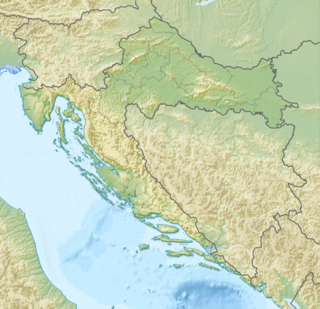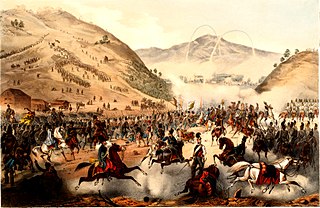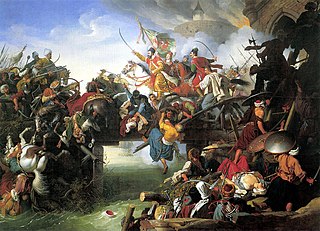 W
WThe Battle of Obreška was fought on 10 September 1565 between the Ottoman forces of Mustafa Pasha Sokolović, Beylerbey of Livno, and the Germanic and Croatian forces led by Croatian ban Petar Erdody. The battle was a part of the Croatian–Ottoman wars and Ottoman–Habsburg wars between the Ottoman Empire and the Habsburg Monarchy.
 W
WThe Siege of Krupa was fought on 3-23 June 1565 between the Ottoman forces of Mustafa Pasha Sokolović, Beylerbey of Livno, and the Germanic and Croatian forces led by Matija Bakić. The siege was a part of the Croatian–Ottoman wars and Ottoman–Habsburg wars between the Ottoman Empire and the Habsburg Monarchy.
 W
WThe Battle of Brest was fought on 19 July 1592 between the Ottoman forces of Hasan Pasha Predojević, Beglerbeg of Bosnia, and the Germanic and Croatian forces led by Tamás Erdődy, Ban of Croatia. The battle was a part of the Croatian–Ottoman wars and Ottoman–Habsburg wars between the Ottoman Empire and the Habsburg Monarchy.
 W
WThe siege of Kőszeg or siege of Güns was a siege of Kőszeg in the Kingdom of Hungary within the Habsburg Empire, that took place in 1532. In the siege, the defending forces of the Austrian Habsburg Monarchy under the leadership of Croatian Captain Nikola Jurišić, defended the small border fort of Kőszeg with only 700–800 Croatian soldiers, with no cannons and few guns. The defenders prevented the advance of the Ottoman army of over 100,000 toward Vienna, under the leadership of Sultan Suleiman the Magnificent and Pargalı Ibrahim Pasha.
 W
WThe siege of Gvozdansko was an Ottoman siege of the fort of Gvozdansko in the Kingdom of Croatia in 1577–1578. In the 1570s, the Ottomans intensified their efforts to capture the valley of the Una River. A string of forts along the Una, centred around Gvozdansko and in possession of the Zrinski noble family, formed the main line of defense of Croatia since 1527. The fort held off Ottoman attacks in 1540 and 1561.
 W
WThe siege of Klis or Battle of Klis was a siege of Klis Fortress in the Kingdom of Croatia within Habsburg Monarchy. The siege of the fortress, which lasted for more than two decades, and the final battle near Klis in 1537, were fought as a part of the Ottoman–Habsburg wars between the defending Croatian–Habsburg forces under the leadership of Croatian feudal lord Petar Kružić, and the attacking Ottoman army under the leadership of the Ottoman general Murat-beg Tardić.
 W
WThe Battle of Lissa took place on 20 July 1866 in the Adriatic Sea near the Dalmatian island of Vis and was a significant victory for an Austrian Empire force over a numerically superior Italian force. It was the first major sea battle between ironclads and one of the last to involve deliberate ramming. The Italian navy fired roughly 1450 shots during the engagement, but failed to sink any Austrian ship while losing two ironclads.
 W
WThe Second Battle of Mohács, also known as the Battle of Harsány Mountain, was fought on 12 August 1687 between the forces of Ottoman Sultan Mehmed IV, commanded by the Grand-Vizier Sari Süleyman Paşa, and the forces of Holy Roman Emperor Leopold I, commanded by Charles of Lorraine. The result was a defeat for the Ottomans.
 W
WThe siege of Novi Zrin ; Croatian: Utvrda Novi Zrin; Hungarian: Új-Zrínyivár; Turkish: Zerinvar) in June/July 1664 was last of the military conflicts between the Croatian forces led by Nikola Zrinski, Ban (viceroy) of Croatia, and the Ottoman army commanded by Köprülü Fazıl Ahmed Pasha, Grand Vizier, dealing with possession of Novi Zrin Castle, defended by Croats, situated on the bank and marshy islands of Mura River, near the border line between northern Croatia and southwestern part of Hungary, at the time occupied by the Ottomans. The battle resulted in destruction of the castle, and retreat of the Croatian crew, that was forced to withdraw to safer territory of inland Croatia.
 W
WThe Battle of Pákozd was a battle in the Hungarian Revolution of 1848, fought on the 29 September 1848 in the Pákozd – Sukoró – Pátka triangle. It was the first and one of the most important battles of the revolution, in which the Hungarian revolutionary army led by Lieutenant-General János Móga clashed with the troops of the Croatian Ban Josip Jelačić.
 W
WThe Battle of Petrovaradin also known as the Battle of Peterwardein, took place on 5 August 1716 during the Austro-Turkish War when the Ottoman army besieged the Habsburgs-controlled fortress of Petrovaradin on the Military Frontier of the Habsburg Monarchy. The Ottomans attempted to capture Petrovaradin, the so-called Gibraltar on the Danube, but experienced a great defeat by an army half the size of their own, similar to the defeat they had experienced in 1697 at Zenta. Ottoman Grand Vizier Damad Ali Pasha was fatally wounded while the Ottoman army lost 20,000 men and 250 guns to the Christian army led by Field Marshal Prince Eugene of Savoy.
 W
WThe Battle of Saint Gotthard, of the Austro-Turkish War (1663–1664), took place on 1 August 1664 on the Raab between Mogersdorf and the Cistercian monastery St. Gotthard in German West Hungary. It was fought between Imperial Army forces, including Germans, Swedish and French contingents, led by Imperial Commander in Chief Count Raimondo Montecuccoli and the army of the Ottoman Empire under the command of Köprülü Fazıl Ahmed Paşa.
 W
WThe Battle of Schwechat was a battle in the Hungarian Revolution of 1848, fought on 30 October 1848 between the revolutionary Hungarian Army against the army of the Austrian Empire, in Schwechat, near Vienna. This was the last battle of 1848 in the Transdanubian campaign. The Hungarian Army was under the command of János Móga and the Austrian Army was under the command of Alfred I, Prince of Windisch-Grätz.
 W
WThe Battle of Sisak was fought on 22 June 1593 between Ottoman Bosnian forces and a combined Christian army from the Habsburg lands, mainly Kingdom of Croatia and Inner Austria. The battle took place at Sisak, central Croatia, at the confluence of the Sava and Kupa rivers, on the borderland between Christian Europe and the Ottoman Empire.
 W
WThe Battle of Slankamen was fought on 19 August 1691, near Slankamen in the Ottoman Sanjak of Syrmia, between the Ottoman Empire, and Habsburg Austrian forces during the Great Turkish War.
 W
WThe Battle of Slunj was fought on 26 October 1584 between the Ottoman forces of the Bosnian Beglerbeg, Ferhad Pasha Sokolović, and Germanic and Croatian forces led by Jobst Joseph von Thurn and Tamás Erdődy, the Ban of Croatia, that ambushed the Ottoman army near the town of Slunj. The battle was a part of the Croatian–Ottoman wars and Ottoman–Habsburg wars between the Ottoman Empire and the Habsburg Monarchy. Ottoman troops were estimated at between 8-10,000 men, and the army of Thurn and Erdödy consisted of 1,330 cavalry and 700 infantry. The battle resulted in a crushing defeat for the Ottoman forces.
 W
WThe siege of Szigetvár or the Battle of Szigeth was a siege of the fortress of Szigetvár, Kingdom of Hungary, that blocked Sultan Suleiman's line of advance towards Vienna in 1566. The battle was fought between the defending forces of the Habsburg Monarchy under the leadership of Nikola IV Zrinski, former Ban of Croatia, and the invading Ottoman army under the nominal command of Sultan Suleiman the Magnificent.
 W
WThe Battle of Zenta, also known as the Battle of Senta, was fought on 11 September 1697, near Zenta, Ottoman Empire, between Ottoman and Holy League armies during the Great Turkish War. The battle was the most decisive engagement of the war, and it saw the Ottomans suffer an overwhelming defeat by an Imperial force half as large sent by Emperor Leopold I.